Samsung Portable SSD T1 Review
by Ganesh T S on January 20, 2015 10:00 AM ESTStorage Benchmarks
Synthetic Benchmarks - ATTO and Crystal DiskMark
Samsung claims read/write speeds of 450 MBps, and these are backed up by the ATTO benchmarks provided below. Unfortunately, these access traces are not very common in real-life scenarios.
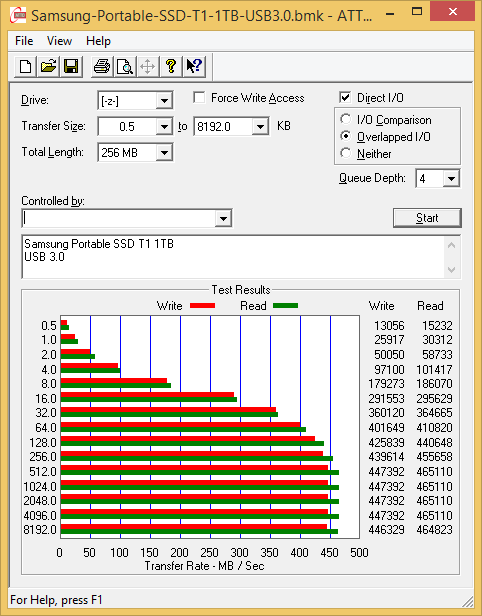
CrystalDiskMark, despite being a canned benchmark, provides a better estimate of the performance range with a selected set of numbers. As evident from the screenshot below, the performance can dip to as low as 26 MBps for 4K accesses at very low queue-depths. It can already be seen from the two benchmarks that enabling encryption doesn't alter the transfer rates at all.
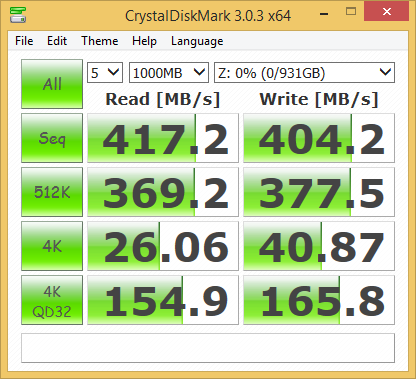
Benchmarks - robocopy and PCMark 8 Storage Bench
Our testing methodology for DAS units also takes into consideration the usual use-case for such devices. The most common usage scenario is transfer of large amounts of photos and videos to and from the unit. The minor usage scenario is importing files directly off the DAS into a multimedia editing program such as Adobe Photoshop.
In order to tackle the first use-case, we created three test folders with the following characteristics:
- Photos: 15.6 GB collection of 4320 photos (RAW as well as JPEGs) in 61 sub-folders
- Videos: 16.1 GB collection of 244 videos (MP4 as well as MOVs) in 6 sub-folders
- BR: 10.7 GB Blu-ray folder structure of the IDT Benchmark Blu-ray (the same that we use in our robocopy tests for NAS systems)





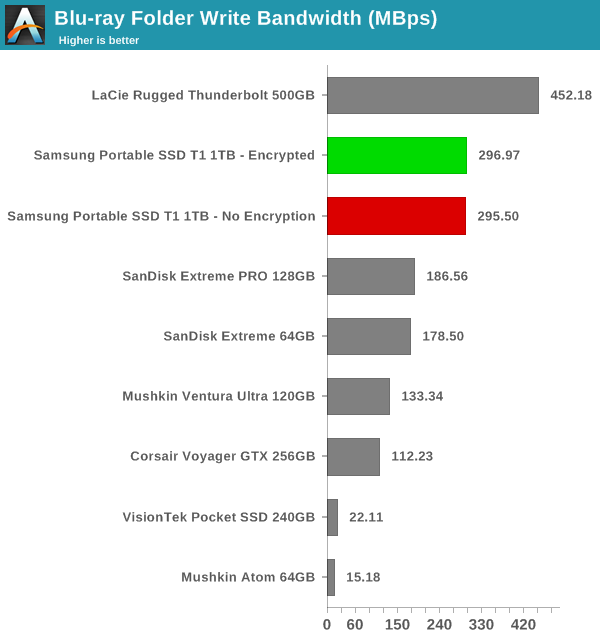
For the second use-case, we take advantage of PC Mark 8's storage bench. The storage workload involves games as well as multimedia editing applications. The command line version allows us to cherry-pick storage traces to run on a target drive. We chose the following traces.
- Adobe Photoshop (Light)
- Adobe Photoshop (Heavy)
- Adobe After Effects
- Adobe Illustrator
Usually, PC Mark 8 reports time to complete the trace, but the detailed log report has the read and write bandwidth figures which we present in our performance graphs. Note that the bandwidth number reported in the results don't involve idle time compression. Results might appear low, but that is part of the workload characteristic. Note that the same testbed is being used for all DAS units. Therefore, comparing the numbers for each trace should be possible across different DAS units.


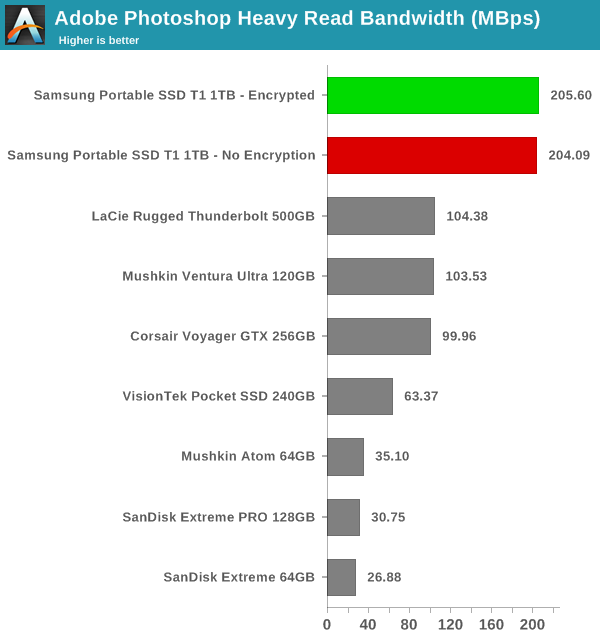

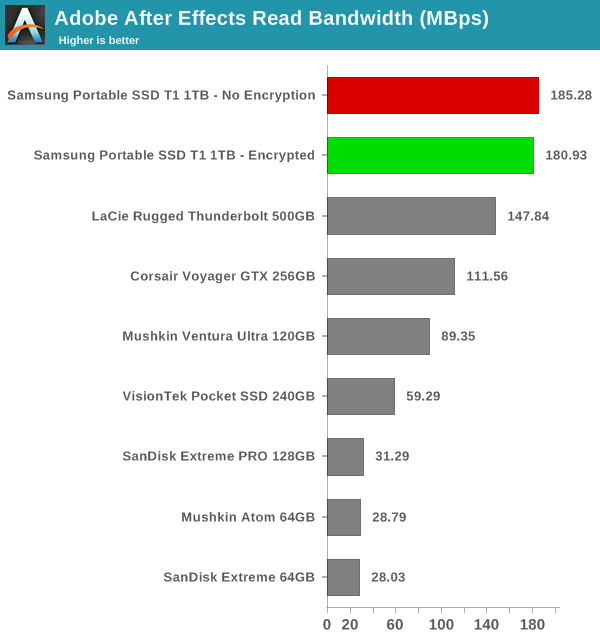
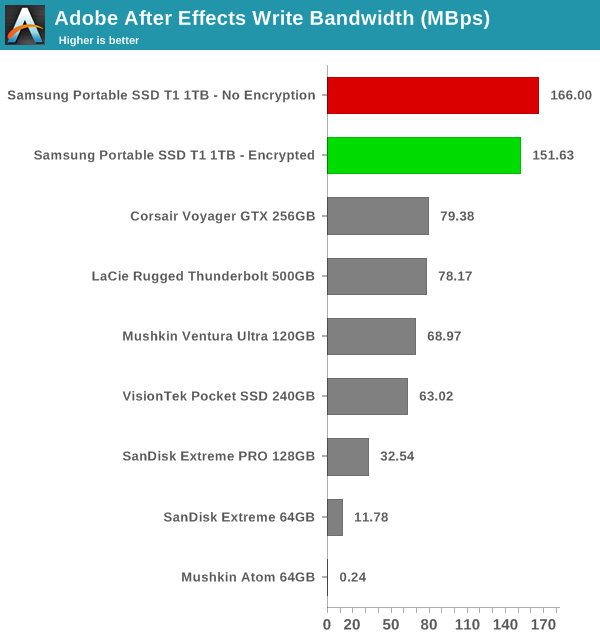
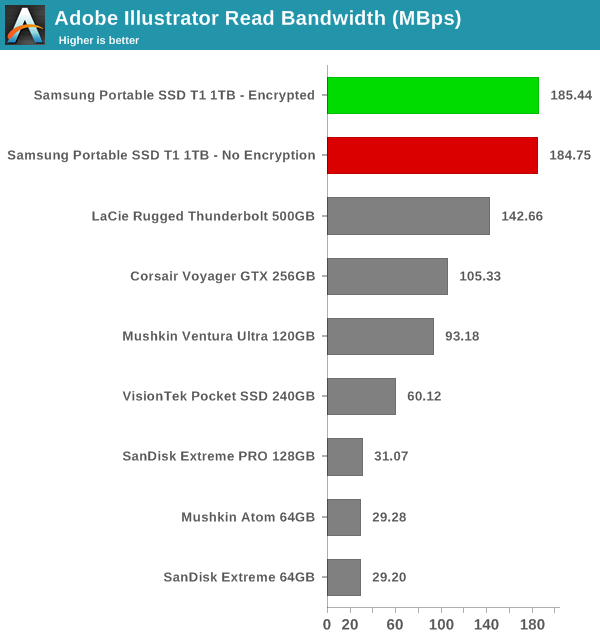

The 1TB Portable SSD T1 manages to win almost all the benchmarks, losing out on a couple of traces to the LaCie Rugged Thunderbolt 500GB version (which, incidentally, carries a Samsung PM851 behind a USB 3.0 - SATA bridge).










68 Comments
View All Comments
Laststop311 - Wednesday, January 21, 2015 - link
So this is a 450 dollar 1tb 850 evo in an external enclosure and a sata to usb chip and interface. So they are trying to say a sata to usb 3.0 bridge and a little enclosure and a tiny usb cable warrants raising the price 150 dollars. They need to cut that in half. 75 dollars extra for those things is more than fair for everyone.baii9 - Wednesday, January 21, 2015 - link
it looks pretty.JohnTheSwed - Friday, January 30, 2015 - link
Something is serious wrong with this test. First I tried with Black Magic Speed test, it said over 400 MB/s write and 432 MB/s read. I have a Macbook Pro Retina 2014. Anyways, you might say that synthetic soo I tried moving files to the external drive, guess what. 18,7 GB of real files took less than 1 minute to move AND I looked in the activity monitor and it said over 400 MB/s. That was real moving files, I can prove it if I have to. Why I get so much better speeds IRL? I don't know.tlaile - Saturday, January 31, 2015 - link
Since this is an external SSD I wondered how many watts it uses when writing to the drive. A normal USB port is one amp at 5 volts, for 5 watts. Some tablets only output half of that. I bought a Crucial M500 and an external USB 3 enclosure to use with a Surface Pro 2. The SSD needs over 3 watts to write and the enclosure uses enough excess that I could only read from the drive unless I use a powered hub.Anandtech reviews always do power consumption tests on internal SSD drives. I assume the reason that the USB external SSD's don't get the same testing is that there is not an easy testing rig to use. However, these drives are either somehow drawing less than 5 watts ever, or they need to be advertised as not compatible with some portable devices. Yes I know that some newer notebook computers can deliver more than one amp on some of their USB ports, but there are still many new devices especially among the well reviewed ultraportables that are limited to 5 watts or even 2.5watts per port. Or am I mistaken.
Ethos Evoss - Saturday, February 7, 2015 - link
why no usb 3.1 ?jondhall - Tuesday, May 12, 2015 - link
I played with Trimcheck and made win8.1 optimise the disk. Trimcheck said trim was working. Using the drive as a Windows boot disk for my macbook and it really good. Just hope the longevity is there, if it is I will be buying more of these.SSDFGD - Monday, August 17, 2015 - link
Hi guys,,We are conducting a Digital Storage Study in New York City, NY between August 27th-August 29th and are looking for people who live in or around the NY Metro area to participate. Currently we need owners of a Samsung Portable T1 SSD.
It will be a 2 hour Focus Group Discussion and if you take part we will compensate you for your time. A focus group discussion is where we invite a group of people to talk about their experiences with a certain product. We would like to speak to you to find out how we can improve upon our products. However, there are a few criteria that you must meet to take part:
• Owner and user of a Samsung Portable T1 SSD,
• Aged between 18-49,
• Must have purchased the Samsung Portable T1 SSD between January 2015 and June 2015.
If you meet the above criteria, it is very likely that you will qualify for our study. If interested, please fill out our pre-survey in the link below. If you qualify, we will reach out to you with an invitation to take part in our focus group.
https://www.surveymonkey.com/r/MT5KKPY
Many thanks in advance